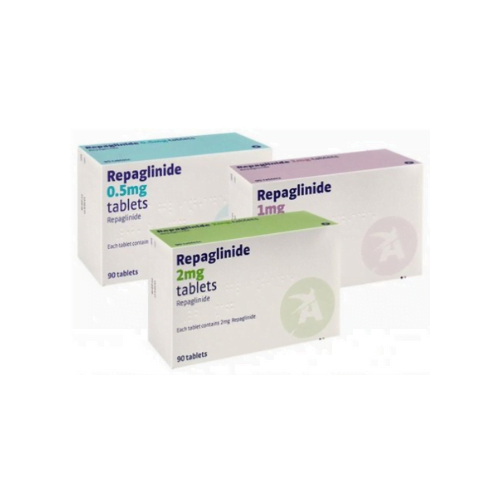Please note: a valid prescription is required for all prescription medication.
Repaglinide is an oral medication used to help manage blood sugar levels in individuals with type 2 diabetes. It belongs to the meglitinide class of drugs and works by stimulating the pancreas to produce insulin in response to meals, helping to control post-meal blood sugar spikes.
Benefits:
- Rapidly lowers blood sugar levels after meals.
- Helps prevent post-meal hyperglycemia.
- Can be used alone or in combination with other diabetes medications like metformin.
- Flexible dosing based on meal patterns, making it suitable for individuals with irregular eating schedules.
- Short duration of action reduces the risk of prolonged hypoglycemia.
Dosage:
- The starting dose is typically 0.5 mg taken before each main meal.
- For individuals previously treated with diabetes medications, the starting dose is usually 1 mg to 2 mg before meals.
- The maximum recommended dose is 16 mg per day, divided among meals.
- Take Repaglinide 15-30 minutes before a meal. Skip the dose if a meal is missed to avoid low blood sugar.
Warnings and Precautions:
- Do not use Repaglinide if you have type 1 diabetes or diabetic ketoacidosis.
- Not recommended for individuals with severe liver impairment.
- Inform your healthcare provider of all medications you are taking, as some drugs may interact with Repaglinide and affect blood sugar levels.
- Monitor blood sugar levels regularly to avoid hypo- or hyperglycemia.
- Avoid alcohol, as it can increase the risk of low blood sugar.
Usage Instructions:
- Take Repaglinide orally 15-30 minutes before each main meal.
- Adjust the dose based on blood sugar monitoring and your healthcare provider’s advice.
- Avoid skipping meals when on Repaglinide to prevent low blood sugar (hypoglycemia).
- Follow your overall diabetes management plan, including diet and exercise.
Storage Information:
- Store Repaglinide at room temperature, below 86°F (30°C).
- Keep the medication in its original container, away from moisture and direct sunlight.
- Keep out of reach of children.
Common Side Effects:
- Low blood sugar (hypoglycemia), particularly if meals are delayed or skipped. Symptoms include dizziness, sweating, and confusion.
- Weight gain, a possible effect of insulin-stimulating medications.
- Gastrointestinal issues like nausea, diarrhea, or constipation.
- Rare allergic reactions, including rash, itching, or swelling. Seek medical attention if these occur.
Our Guarantee
CanadianInsulin.com will provide the lowest price for Repaglinide from Canada. We guarantee your order will be shipped from a licensed Canadian pharmacy. All of our discount diabetes products are shipped fast from Canada, straight to your door. To buy this diabetic medicine online, please call us at 1-844-560-7790 toll-free.
Express Shipping - from $25.00
Shipping with this method takes 3-5 days
Prices:
- Dry-Packed Products $25.00
- Cold-Packed Products $35.00
Standard Shipping - $15.00
Shipping with this method takes 5-10 days
Prices:
- Dry-Packed Products $15.00
- Not available for Cold-Packed products
How does Repaglinide work?
How does Repaglinide work?
Repaglinide stimulates the pancreas to produce insulin quickly after meals, helping to control blood sugar spikes. It mimics the natural insulin response of the body.Can Repaglinide be combined with other diabetes medications?
Can Repaglinide be combined with other diabetes medications?
Yes, Repaglinide is often used with other drugs like metformin to improve overall blood sugar control. Your healthcare provider will determine the best combination for your needs.What should I do if I miss a dose?
What should I do if I miss a dose?
If you miss a dose, skip it and take your next dose as scheduled before your next meal. Do not take a double dose to make up for the missed one.Is Repaglinide safe during pregnancy?
Is Repaglinide safe during pregnancy?
Repaglinide is not typically recommended during pregnancy. If you are pregnant or planning to become pregnant, consult your healthcare provider for alternative diabetes management options.Who should avoid taking Repaglinide?
Who should avoid taking Repaglinide?
Individuals with type 1 diabetes, diabetic ketoacidosis, or severe liver problems should not use Repaglinide. Always consult your healthcare provider before starting the medication.
Rewards Program
Earn points on birthdays, product orders, reviews, friend referrals, and more! Enjoy your medication at unparalleled discounts while reaping rewards for every step you take with us.
You can read more about rewards here.
POINT VALUE
How to earn points
- 1Create an account and start earning.
- 2Earn points every time you shop or perform certain actions.
- 3Redeem points for exclusive discounts.
You Might Also Like
Related Articles
Soliqua Solostar Pen – One Pen, Dual-Action Support
Managing type 2 diabetes can be a complicated journey, especially when your current treatment plan isn’t helping you meet your blood sugar goals. That’s where the Soliqua Solostar Pen comes…
How SGLT2 Inhibitors Are Changing Heart Failure Care
Heart failure is a long-term health condition impacting millions worldwide. It occurs when the heart can’t pump blood efficiently, resulting in symptoms like fatigue, breathlessness, and swelling. Traditionally, treatment has…
Basaglar Cartridge: Long-Acting Insulin for Diabetes
Managing diabetes requires consistent attention, especially when it comes to regulating blood sugar levels. Among the tools used in long-term diabetes care is long-acting insulin, and one notable option is…
Xultophy® Prefilled Pen: Insulin + GLP-1 for Diabetes Care
Managing type 2 diabetes is often a balancing act that involves careful monitoring, lifestyle adjustments, and effective medication. For many patients, finding a treatment that delivers strong blood sugar control…



